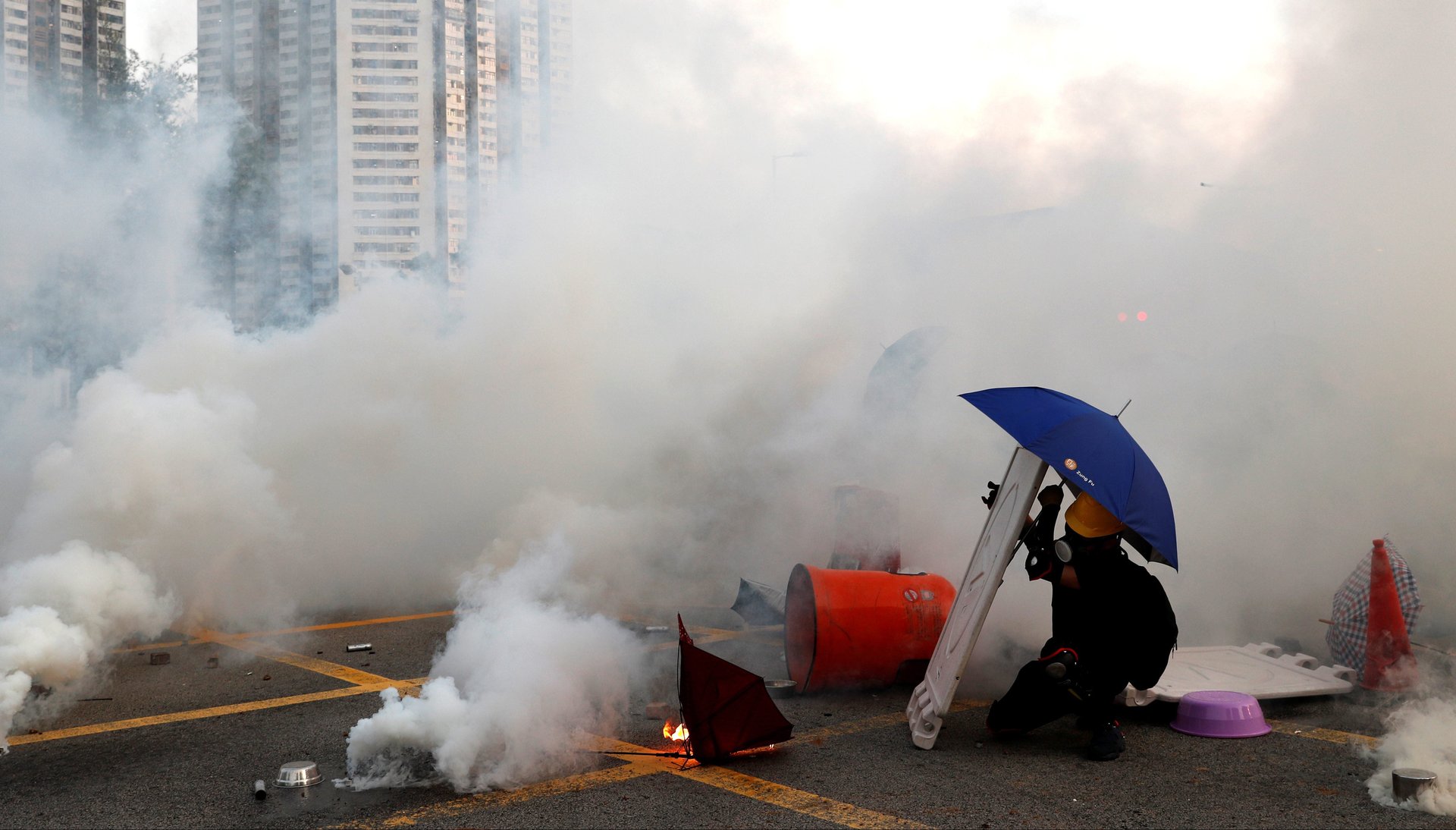In Hong Kong, almost everyone, everywhere—including pets—is getting tear gassed
This story has been updated.


This story has been updated.
Volley after volley, police have fired an unprecedented number of tear gas canisters on the streets of Hong Kong. The people they’re meant to disperse—protesters—have long since become experts at putting out the projectiles by dousing them with water and covering them with metal dinner plates, wok lids, and traffic cones. Now, it’s passersby—ordinary residents, children, the elderly, and even pets—who are bearing the brunt of the pungent, searing substance.
In the nine weeks between when protests kicked off on June 9 and last Sunday (Aug. 4), police fired some 1,000 rounds of tear gas. This was already orders of magnitude more than the 87 rounds fired during the 2014 Umbrella Movement, when protesters occupied streets across three districts for two months. But what transpired on Monday (Aug. 5) blew those proportions completely out the water. As protesters launched a paralyzing general strike and held multiple rallies throughout the city, police unleashed an astounding 800 tear gas canisters in a single day. By now, tear gas has been fired in 14 of the city’s 18 districts.
Given Hong Kong’s compact geography, many protests in recent weeks have taken place in densely populated residential areas, where narrow streets and packed buildings combine to potentially create a funnel effect, increasing the potency of any tear gas deployment. Often, residents are given no or little forewarning by the police on imminent tear gas use, and as a result are caught unawares while at home, dining out, or just strolling the streets.
At a protest in the suburban town of Yuen Long in late July, police fired large amounts of tear gas in an area with numerous elderly homes. While the police claimed that sufficient warning had been given to the care centers and insisted that no elderly people had been affected, photo and video evidence suggested otherwise.
At a press conference on Tuesday (Aug. 6), the police responded to questions over their decision to fire tear gas in dense residential areas by pointing a finger straight back at protesters. “We didn’t choose the neighborhoods; it’s the violent protesters who chose,” said senior superintendent Kong Wing-cheung. “So we’re forced to use tear gas in residential areas.”
The Practising Pharmacists Association of Hong Kong has pressed the police to stop firing tear gas in residential areas (link in Chinese), saying that doing so poses a public health problem, and asked the Food and Environmental Hygiene Department to work with the police to set up clear geographic boundaries for tear gas deployment.
According to a study conducted by three medical students at the University of Hong Kong and a practicing doctor, almost all journalists surveyed following a police dispersal operation on July 28 reported suffering health implications including residual respiratory symptoms, skin reactions, eye symptoms, and gastrointestinal problems. The researchers said that there are “worsening effects” of tear gas on reporters who have been exposed to the substance, and that there’s “no doubt” that the police are endangering the health of citizens with their use of tear gas, which has increased in frequency and scope. They also described the police’s indiscriminate use of the chemical as a “tear gas buffet” that could arguably amount to torture.
It appears that even pets have been affected by tear gas. At another spontaneous protest this week, which sprung up in response to news of a student having been arrested for being in possession of ten laser pointers, tear gas was fired reportedly with little apparent warning. A staff member at the nearby City University Veterinary Medical Centre told local broadcaster RTHK (link in Chinese) that cats had to be evacuated from a room because tear gas had filtered in. In a statement to Quartz, however, the medical centre said that patients “have not been affected by recent events.” In response to growing concerns by pet owners, Hong Kong’s Society for the Protection of Animals posted guidelines on Facebook this week on what to do if pets are exposed to tear gas, advising owners to immediately wash the pet’s eyes with saline and take the pet in question to a vet if it shows symptoms such as difficulty breathing and swollen eyes.
Citizens have also pressed the police to explain the effects of being exposed to tear gas, especially in light of suspicions that some canisters fired were well past their expiry dates. When asked on multiple occasions at press conferences whether expired tear-gas canisters were indeed fired, and whether tear gas past their use-by dates were more toxic, the police have yet to answer directly and merely repeated that they have followed stringent safety guidelines.